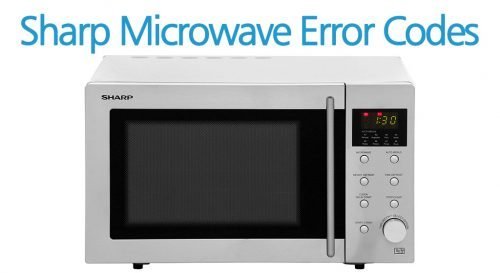
In the simplest terms, the “LE” error code on your Sharp microwave usually indicates a problem with the microwave’s door. Think of it like a safety mechanism. When the door isn’t closed properly, the microwave’s internal sensors kick in to prevent it from operating. It’s like trying to drive a car with the doors wide open — not exactly safe, right? But what exactly could cause your microwave to think the door isn’t shut properly when you’re sure it is?
Understanding the ‘LE’ Error Code on Sharp Microwaves
The “LE” error code is akin to a red flag, signaling that something isn’t quite right with the door latch or its sensing mechanism. This could be due to debris blocking the latch, a misalignment in the door, or a faulty door switch. Imagine a school locker that just won’t shut because the latch is jammed — it’s the same principle. Your microwave door needs to seal perfectly to work correctly, and any obstruction or fault can trigger this error.
You might wonder if it’s okay to just overlook this and keep using the microwave. Well, while it might be tempting to just try reopening and closing the door more forcefully, it’s crucial to address the underlying cause rather than just hoping it’ll go away. Ignoring it could lead to more significant issues — like permanent damage to the door switch or, worse, a non-functioning microwave. It’s kind of like ignoring a check engine light in your car; eventually, it could lead to more serious and costly problems.
Before you consider tossing out your microwave or calling a repair technician, there are a couple of things you can try. First, clean the area around the door and latch. Sometimes crumbs or food particles can get caught, preventing a proper closure. Also, check for any visible damage or misalignment in the door. If these steps don’t resolve the “LE” error, further investigation or professional help might be necessary.
Why Ignoring It Isn’t a Good Idea
You might think that as long as the microwave heats your food, this error isn’t a big deal. However, ignoring the “LE” code isn’t just about risking the functionality of your microwave — it’s also about safety. Microwaves use high-frequency energy to heat food, and an improperly sealed door can lead to energy leakage.
Imagine a leaky garden hose; instead of watering your plants, you end up soaking your shoes. In a similar way, an unsealed microwave door means that energy could escape, potentially causing harm to the user or damaging the interior components of the microwave. Not to mention, it could cause inefficient heating, leading to cold spots in your food, or extend heating times.
Thus, it’s prudent to address the issue early on. By fixing the problem promptly, you ensure your microwave works efficiently and safely, extending its lifespan and ensuring it continues to perform as expected. It’s like maintaining any other appliance or vehicle — a little attention now can save a lot of headaches later.
Steps to Resolve the ‘LE’ Error Yourself
Here’s the deal: before you panic and assume the worst, there are a few troubleshooting steps you can take on your own. First, ensure that the microwave is unplugged — safety first! Then, check the door latch mechanism. Is it clean and free from obstructions? Sometimes, a simple wipe-down with a damp cloth can do wonders.
Next, examine the door switches. They’re usually small plastic components that click when the door is opened or closed. You might find them behind a small panel on the door frame. If you feel comfortable, you can check to see if they’re loosely connected or appear damaged. If they don’t click when pressed, they might be worn out and need replacement.
If you’ve gone through these steps and the code persists, it might be time to reach out to a professional. Remember, it’s like when you’ve tried everything to fix a flickering light but it still won’t behave — sometimes, you just need an expert.
Preventing Future Errors
Preventative care is always the best medicine, even when it comes to appliances. To avoid the “LE” error sneaking up on you again, regularly clean around the microwave door and hinges. Make sure to open and close the door gently, as slamming it can cause misalignment or damage over time. It’s a bit like handling a delicate piece of art — gentle and careful movements can go a long way.
Also, try to regularly inspect and test the door’s function and alignment. If the microwave seems to be rocking or wobbling, check that it’s placed on a flat, stable surface. An uneven surface can lead to additional stress on the door, leading to more frequent errors.
By taking these simple preventative measures, you’ll keep your microwave in top shape, ensuring it remains a reliable kitchen companion for years to come. And there you have it — no more wondering or worrying about that pesky “LE” error. Address it early, handle it gently, and you’ll keep your trusty appliance working like a charm.